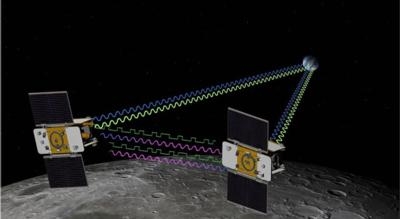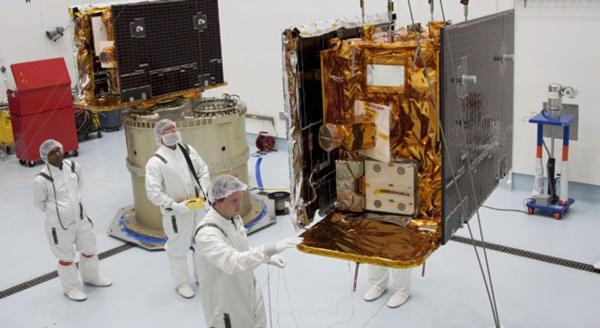NASA's Twin Spacecraft On Final Approach For Moon
Now... this what we call celebrating the holiday... with further
exploration of our Moon. NASA's twin spacecraft to study the moon
from crust to core are nearing their New Year's Eve and New Year's
Day main-engine burns to place the duo in lunar orbit. Named
Gravity Recovery And Interior Laboratory (GRAIL), the spacecraft
are scheduled to be placed in orbit beginning at 1:21 p.m. PST
(4:21 p.m. EST) for GRAIL-A on Dec. 31, and 2:05 p.m. PST (5:05
p.m. EST) on Jan. 1 for GRAIL-B.

"Our team may not get to partake in a traditional New Year's
celebration, but I expect seeing our two spacecraft safely in lunar
orbit should give us all the excitement and feeling of euphoria
anyone in this line of work would ever need," said David Lehman,
project manager for GRAIL at NASA's Jet Propulsion Laboratory (JPL)
in Pasadena, Calif.
The distance from Earth to the moon is approximately 250,000
miles. NASA's Apollo crews took about three days to travel to the
moon. Launched from Cape Canaveral Air Force Station Sept. 10,
2011, the GRAIL spacecraft are taking about 30 times that long and
covering more than 2.5 million miles to get there. This low-energy,
long-duration trajectory has given mission planners and controllers
more time to assess the spacecraft's health. The path also allowed
a vital component of the spacecraft's single science instrument,
the Ultra Stable Oscillator, to be continuously powered for several
months. This will allow it to reach a stable operating temperature
long before it begins making science measurements in lunar
orbit.
"This mission will rewrite the textbooks on the evolution of the
moon," said Maria Zuber, GRAIL principal investigator from the
Massachusetts Institute of Technology (MIT) in Cambridge. "Our two
spacecraft are operating so well during their journey that we have
performed a full test of our science instrument and confirmed the
performance required to meet our science objectives."

As of Dec. 28, GRAIL-A is 65,860 miles from the moon and closing
at a speed of 745 mph. GRAIL-B is 79,540 miles from the moon and
closing at a speed of 763 mph. During their final approaches to the
moon, both orbiters move toward it from the south, flying nearly
over the lunar south pole. The lunar orbit insertion burn for
GRAIL-A will take approximately 40 minutes and change the
spacecraft's velocity by about 427 mph. GRAIL-B's insertion burn 25
hours later will last about 39 minutes and is expected to change
the probe's velocity by 430 mph.
The insertion maneuvers will place each orbiter into a
near-polar, elliptical orbit with a period of 11.5 hours. Over the
following weeks, the GRAIL team will execute a series of burns with
each spacecraft to reduce their orbital period from 11.5 hours down
to just under two hours. At the start of the science phase in March
2012, the two GRAILs will be in a near-polar, near-circular orbit
with an altitude of about 34 miles.
When science collection begins, the spacecraft will transmit
radio signals precisely defining the distance between them as they
orbit the moon. As they fly over areas of greater and lesser
gravity, caused both by visible features such as mountains and
craters and by masses hidden beneath the lunar surface. they will
move slightly toward and away from each other. An instrument aboard
each spacecraft will measure the changes in their relative velocity
very precisely, and scientists will translate this information into
a high-resolution map of the Moon's gravitational field. The data
will allow mission scientists to understand what goes on below the
surface. This information will increase our knowledge of how Earth
and its rocky neighbors in the inner solar system developed into
the diverse worlds we see today.
JPL manages the GRAIL mission. MIT is home to the mission's
principal investigator, Maria Zuber. The GRAIL mission is part of
the Discovery Program managed at NASA's Marshall Space Flight
Center in Huntsville, Ala. Lockheed Martin Space Systems in Denver
built the spacecraft.
 Airborne 07.21.25: Nighthawk!, Hartzell Expands, Deltahawk 350HP!
Airborne 07.21.25: Nighthawk!, Hartzell Expands, Deltahawk 350HP! ANN's Daily Aero-Term (07.27.25): Estimated (EST)
ANN's Daily Aero-Term (07.27.25): Estimated (EST) ANN's Daily Aero-Linx (07.27.25)
ANN's Daily Aero-Linx (07.27.25) NTSB Final Report: Luce Buttercup
NTSB Final Report: Luce Buttercup Classic Aero-TV: 'That's All Brother'-Restoring a True Piece of Military History
Classic Aero-TV: 'That's All Brother'-Restoring a True Piece of Military History




